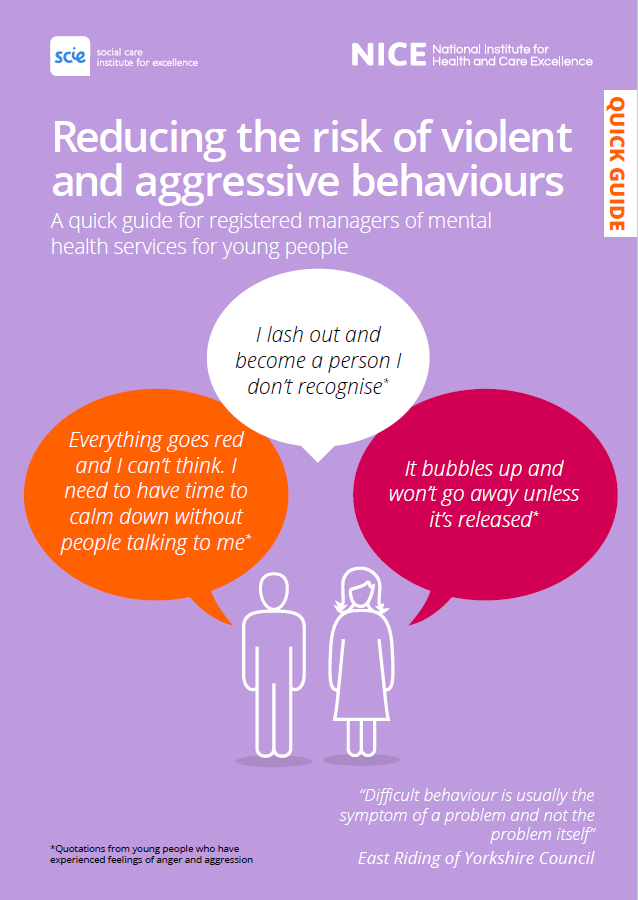A quick guide for registered managers of mental health services for young people
Violent and aggressive behaviours have a huge impact, affecting the health and safety of the young person as well as carers, staff and others using the service.
As far as possible, focus on preventing, anticipating and reducing the risk of violent and aggressive behaviour occurring.
Involve the young person in decisions about their care wherever possible, and collaborate with whoever has parental responsibility. When supporting the young person to manage and minimise any violent or aggressive behaviours, consider their physical, intellectual, emotional and psychological maturity, including any variation in their development.
Preventing violent and aggressive behaviours
Understanding the likely causes of violent and aggressive behaviours helps to prevent them happening. Together with the young person, when they are in a calm and safe space.
Think about times when they have shown violent or aggressive behaviour, and what might have triggered it.
Triggers can be:
- something that happened or a feeling such as disappointment or anger
- shaped by delusions, hallucinations, confusion, disorientation, or misinterpretation
- affected by their perception of the environment or the behaviour of others.
Consider their history, including any experience of abuse or trauma and how they responded during any previous incidents of violent and aggressive behaviour.
Talk about what happens when they are becoming distressed and angry, and what helps them to feel calmer.
Identify any cognitive, language, communication or cultural factors that might increase the risk of violent and aggressive behaviour.
Record this information in the care plan and support the young person, if they wish, to make an advance statement recording their wishes in case they become agitated in future.
This could include what they would find acceptable, when and how staff should intervene and how to minimise harm or discomfort should restrictive interventions be needed.
Give copies of this information to the young person and make sure they understand it.
Difficult behaviour is usually the symptom of a problem and not the problem itself.
De-escalation
De-escalation means using techniques, both verbal and non-verbal, to reduce agitation and avoid violent and aggressive behaviour. It may include the use of ‘when needed’ medication in combination with other techniques.
De-escalation requires advance planning and it is more likely to be successful when staff:
- Have a close working relationship with the young person and are able to sensitively monitor changes in their mood or composure.
- Show respect and empathy at all times.
- Use verbal and non-verbal skills to help the young person avoid or manage situations that are known to be difficult.
- Encourage the young person to recognise their own triggers and early warning signs.
- Consider whether the young person might benefit from help to develop greater self-control and techniques for self-soothing.
If the young person becomes agitated:
- start any actions agreed in their care plan and advance plan straightaway
- use one member of staff as the main communicator
- control your own verbal and non-verbal expressions of anxiety or frustration
- use calming techniques and distraction
- offer them the opportunity to move away to a quiet room or area
- keep in mind the aim to build emotional bridges and maintain a relationship.
Only use restrictive interventions if all attempts to defuse the situation have failed and there is a risk of harm to the young person or other people. Continue to attempt de-escalation during the restrictive intervention.

Training
To help reduce the risk of violent and aggressive behaviours, and avoid the use of restrictive interventions wherever possible, staff should have training specific to working with young people. Training should include a focus on de-escalation and cover:
- the early signs of agitation, irritation, anger and aggression
- the likely causes of aggressive or violent behaviour
- de-escalation techniques and ways to encourage relaxation
- the importance of personal space
- how to respond to agitation in a reasonable and professional way that avoids provocation.

Anyone who might use restrictive interventions should be trained in how to do so safely with young people.

Staff should be aware of relevant legislation, organisational policies and procedures, and how to respond effectively and appropriately.

Share information within the organisation about the triggers and early warning signs identified by the young people using the service to help inform learning and practice.
Further information
- NICE guideline, which includes recommendations on a range of appropriate restrictive interventions: Violence and aggression - short-term management in mental health, health and community settings (NG10)
- NICE quality standard: Violent and aggressive behaviours in people with mental health problems (QS154)
- NICE guideline: Decision making and mental capacity (NG108)
- Relevant legislation: Children Act 1989 and Children Act 2004; Mental Health Act 1983, Mental Capacity Act 2005, Human Rights Act 1998, United Nations Convention on the Rights of the Child
- YoungMinds: Resource that can help young people with mental health problems think about and understand their feelings of anger.

Download this guide
We've created a copy of this guide that you can print and share:
Reducing the risk of violent and aggressive behaviours (PDF)
This content has been co-produced by NICE and the social care institute for excellence (SCIE). It is based on NICE’s guideline and quality standard on violence and aggression.